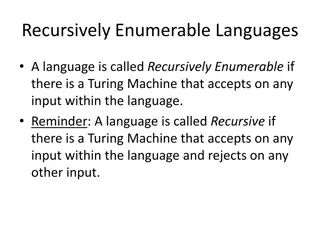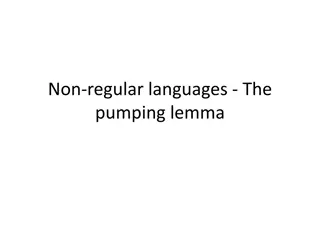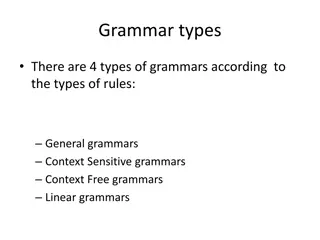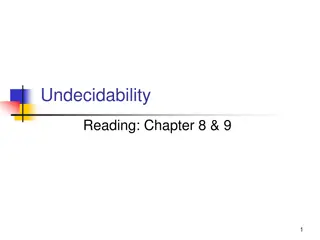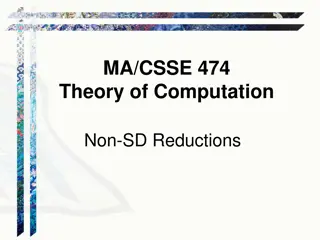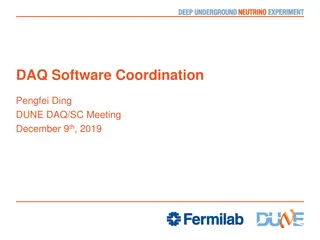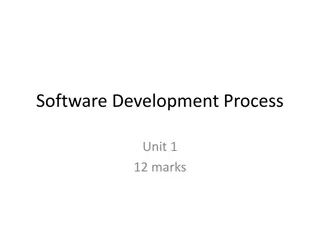Understanding Languages in Software Development
Exploring the fundamentals of languages in software development, this content covers natural languages, programming languages, and the components of a language like symbols, grammar, and semantics. It delves into the differences between natural and programming languages, highlighting the essential role of compilers, interpreters, and assemblers in language translation.
Download Presentation

Please find below an Image/Link to download the presentation.
The content on the website is provided AS IS for your information and personal use only. It may not be sold, licensed, or shared on other websites without obtaining consent from the author. Download presentation by click this link. If you encounter any issues during the download, it is possible that the publisher has removed the file from their server.
E N D
Presentation Transcript
Software Lesson 2 Outline 21. 22. 23. 24. 25. 26. 27. 28. 29. 30. 31. 32. 33. 34. 35. 36. 37. 38. 39. Our Old Friend hello_world.c Compiler Details Compiler Details (cont d) Elements of a Compiler #1 Elements of a Compiler #2 Phases of Compiling Compiling a C Statement Assembly Code for hello_world.c #1 Assembly Code for hello_world.c #2 Machine Code for hello_world.c How to Program in Machine Language Directly Why Not Do Everything in Machine Language? Why Not Do Everything in Assembly Language? The Programming Process What is an Algorithm? Algorithms Algorithm Example: Eating a Bowl of Corn Flakes Top-Down Design Eating Cornflakes: Top Level 1. 2. 3. 4. 5. 6. Software Lesson 2 Outline Languages Ingredients of a Language Kinds of Languages Natural Languages: How Many? Natural Languages Don t Have to Arise Naturally Natural Languages Can Be Flexible Natural Languages Can Be Mixed Together Natural Languages Can Be Ambiguous 10. Natural Languages Can Be Flexible About Correctness 11. Programming Languages 12. Natural Languages vs Programming Languages 13. Programming Language Hierarchy 14. High Level Languages 15. Assembly Languages 16. Machine Languages 17. Converting Between Languages 18. Compiler 19. Interpreter 20. Assembler 7. 8. 9. Software Lesson #2 CS1313 Fall 2024 1
Languages What is a language? Kinds of languages Natural languages Programming languages (also known as Formallanguages) Converting between programming languages Compilers Interpreters Assemblers Software Lesson #2 CS1313 Fall 2024 2
Ingredients of a Language Symbols: a set of wordsand punctuation(in computing, words and punctuation are collectively known as tokens) Grammar(also known as syntax): a set of rules for putting symbols together to get valid statements Semantics: a set of rules for interpreting the meaning of a grammatically valid statement Software Lesson #2 CS1313 Fall 2024 3
Kinds of Languages Natural languages: used in human communication Programming languages (also known as formal languages): used by computers (among others) Software Lesson #2 CS1313 Fall 2024 4
Natural Languages: How Many? There are said to be 7000+ natural languages in the world: https://www.ethnologue.com/guides/how-many-languages Examples: English, Chinese, Swahili, Navajo, Quechua, Maori https://www.reddit.com/r/dataisbeautiful/comme nts/t5oitk/most_spoken_languages_in_the_world _oc/?rdt=36221 Software Lesson #2 CS1313 Fall 2024 5
Natural Languages Dont Have to Arise Naturally Not all natural languages arise naturally some are created by people, on purpose. https://en.wikipedia.org/wiki/Worf https://en.wikipedia.org/wiki/Jabba_the_Hutt https://en.wikipedia.org/wiki/Incubus_(1966_film) https://en.wikipedia.org/wiki/Legolas Software Lesson #2 CS1313 Fall 2024 6
Natural Languages Can Be Flexible Natural languages typically can be described by formal rules (grammar), but often aren t rigidly governed by these rules in everyday use: Any noun can be verbed. I might could get me one o them there computers. Software Lesson #2 CS1313 Fall 2024 7
Natural Languages Can Be Mixed Together Natural languages CAN mix words from different languages and even syntax(elements of grammar) from different languages in a single sentence: Hey, amigo, is it all right by you if I kibbitz your pachisi game while we watch your anime? https://en.wikipedia.org/wiki/Parcheesi https://www.indiewire.com/gallery/the-20-most-iconic-characters-in-studio-ghibli-history/big-totoro/ Software Lesson #2 CS1313 Fall 2024 8
Natural Languages Can Be Ambiguous Natural languages CAN be ambiguous: When did he say she was going? could be interpreted as: State the time at which he said the words She was going. OR According to him, at what time was she going? You can t put too much water in a nuclear reactor. could be interpreted as: You shouldn t put a lot of water in a nuclear reactor. OR There s no upper limit to how much water you can put in a nuclear reactor. https://www.onesnladay.com/wp- content/uploads/2019/02/11-17- 1984_0.53.55.00-300x225.jpg Software Lesson #2 CS1313 Fall 2024 9
Natural Languages Can Be Flexible About Correctness Natural languages can have plenty of flexibility regarding correctness; for example, ain t, split infinitives, ending a sentence with a preposition. That is something up with which I will not put. Software Lesson #2 CS1313 Fall 2024 10
Programming Languages Examples: C, Java, HTML, Haskell, SAS Also known as formal languages Completely described and rigidly governed by formal rules Cannot mix the words of multiple languages, or the syntax of multiple languages, in the same program Cannot be ambiguous Words and syntax must be EXACTLY correct in every way Software Lesson #2 CS1313 Fall 2024 11
Natural Languages vs Programming Languages PROPERTY Completely described and rigidly governed by formal rules CAN mix the words of multiple languages, or the syntax of multiple languages, in the same program CAN be ambiguous NAT L PROG no YES YES no YES no YES Words and syntax must be EXACTLY correct in every way no Software Lesson #2 CS1313 Fall 2024 12
Programming Language Hierarchy High Level Languages Assembly Languages Machine Languages Software Lesson #2 CS1313 Fall 2024 13
High Level Languages Human-readable Most are standardized, so they can be used on just about any kind of computer. Examples: C, Fortran 90, Java, HTML, Haskell, SAS Typically, they are designed for a particular kind of application; for example: C for operating system design Fortran 90 for scientific & engineering applications Java for embedded systems (originally designed for interactive TV) HTML for hypertext (webpages) SAS for statistics But often, their uses in real life are broader their original purpose. Software Lesson #2 CS1313 Fall 2024 14
Assembly Languages Human-readable Specific to a particular CPU family; for example: Intel/AMD x86 (PCs, servers, some handhelds) ARM (handhelds such as smartphones and tablets) IBM POWER (server computers) So, for example, a program in x86 assembly language cannot be directly run on a machine with an ARM CPU. Set of simple commands; for example: Load a value from a location in main memory Add two numbers Branch to an instruction out of sequence Software Lesson #2 CS1313 Fall 2024 15
Machine Languages Not human-readable, except with immense effort Binary code that the CPU family understands directly Binary representation of the CPU family s assembly language Software Lesson #2 CS1313 Fall 2024 16
Converting Between Languages Compilers, interpreters and assemblers are programs that convert human-readable source code into machine-readable executable code. Software Lesson #2 CS1313 Fall 2024 17
Compiler Converts a human-readable high level language source code of a program into a machine language executableprogram Converts an entire source code all at once Must be done before executing the program Example compiled languages: Fortran, C, C++, Pascal Software Lesson #2 CS1313 Fall 2024 18
Interpreter Converts a human-readable high level language source code into actions that are immediately performed Converts and executes one statement at a time Conversion and execution alternate Example interpreted languages: Perl, HTML, SAS, Mathematica, Unix shell (interactive system within Unix) Software Lesson #2 CS1313 Fall 2024 19
Assembler Converts a human-readable CPU-specific assembly code into CPU-specific, non-human-readable machine language Like a compiler, but for a low level assembly language instead of for a high level language Software Lesson #2 CS1313 Fall 2024 20
Our Old Friend hello_world.c % cat hello_world.c /* ************************************************* *** Program: hello_world *** *** Author: Henry Neeman (hneeman@ou.edu) *** *** Course: CS 1313 010 Fall 2024 *** *** Lab: Sec 014 Fridays 1:00pm *** *** Description: Prints the sentence *** *** "Hello, world!" to standard output. *** ************************************************* */ #include <stdio.h> int main () { /* main */ /* ******************************** *** Execution Section (body) *** ******************************** * * Print the sentence to standard output * (i.e., to the terminal screen). */ printf("Hello, world!\n"); } /* main */ % gcc -o hello_world hello_world.c % hello_world Hello, world! Software Lesson #2 CS1313 Fall 2024 21
Compiler Details Software Lesson #2 CS1313 Fall 2024 22
Compiler Details (contd) Software Lesson #2 CS1313 Fall 2024 23
Elements of a Compiler #1 Lexical Analyzer: identifies a program s word elements: Keywords(for example, int, while) These are built into the programming language and cannot be changed by programmers. Literal constants(for example, 5, 0.725, "Hello, world!", delimited by double quotes on both ends) User-defined identifiers (for example, addend) Operators; for example: Arithmetic: + - * / % Relational: == != < <= > >= Logical: && || ! These will be explained soon. Software Lesson #2 CS1313 Fall 2024 24
Elements of a Compiler #2 Parser: determines the program s grammar Semantic Analyzer: determines what the program does Intermediate Code Generator: expresses, as an assembly-like program, what the program does Optimizer: makes code more efficient (faster) Assembly Code Generator: produces the final assembly code that represents what the program does Software Lesson #2 CS1313 Fall 2024 25
Phases of Compiling Compiler Assembler: turns assembly code into machine code Linker/loader: turns machine code into an executable file Both the assembler and the linker/loader are invoked automatically by the compiler, so you don t have to worry about them. Software Lesson #2 CS1313 Fall 2024 26
Compiling a C Statement Software Lesson #2 CS1313 Fall 2024 27
Assembly Code for hello_world.c #1 On Pentium4 Using gcc On IBM POWER4 Using gcc pushl %ebp movl %esp, %ebp subl $8, %esp subl $12, %esp pushl $.LC0 call printf addl $16, %esp leave ret mflr 0 stw 31,-4(1) stw 0,8(1) stwu 1,-64(1) mr 31,1 lwz 3,LC..1(2) bl .printf nop lwz 1,0(1) lwz 0,8(1) mtlr 0 lwz 31,-4(1) blr Different opcodes (assembly language instructions) Software Lesson #2 CS1313 Fall 2024 28
Assembly Code for hello_world.c #2 On Pentium4 Using gcc (GNU compiler) pushl %ebp movl %esp, %ebp subl $8, %esp subl $12, %esp pushl $.LC0 call printf addl $16, %esp leave ret Different sequences of instructions (using the same opcodes) On Pentium4 Using icc (Intel compiler) pushl %ebp movl %esp, %ebp subl $3, %esp andl $-8, %esp addl $4, %esp push $__STRING.0 call printf xorl %eax, %eax popl %ecx movl %ebp, %esp popl %ebp ret Software Lesson #2 CS1313 Fall 2024 29
Machine Code for hello_world.c 10111101010100010101011110101001 10111010101000010101101011101000 01110101010000101011010111010001 01010100101010101101010101011010 ... Software Lesson #2 CS1313 Fall 2024 30
How to Program in Machine Language Directly 1. Write the assembly code for the program directly by hand on paper (that is, not in a high level language). For each assembly language instruction, look up the bit pattern of the associated machine code. On the computer console, flip switches to match the bit pattern of the machine code. Press the Run button. 2. 3. 4. On modern computers, programming directly in machine language is just about impossible. Software Lesson #2 CS1313 Fall 2024 31
Why Not Do Everything in Machine Language? Incredibly tedious and ridiculously error-prone! Fun and easy! Not nearly as tedious or error-prone! Software Lesson #2 CS1313 Fall 2024 32
Why Not Do Everything in Assembly Language? Can t be run on any other kind of computer. May be completely obsolete in a few years. Software Lesson #2 CS1313 Fall 2024 33
The Programming Process Compile Formulate Problem Yes Bugs? Debug Construct Algorithm No Choose Programming Language Run Yes Bugs? Write Program No Get an A/Impress Your Boss/Sell for Zillions! Software Lesson #2 CS1313 Fall 2024 34
What is an Algorithm? An algorithm is: a step-by-step method that is written in a natural language (for example, English) or in pseudocode(something that sort of looks like a programming language but isn t as precise), instead of in a programming language, that solves a well-defined (though not necessarily useful) problem, on a well-defined set of inputs (which may be empty), using finite resources(for example, computing time and storage), and that produces a well-defined set of outputs (which may be empty). Software Lesson #2 CS1313 Fall 2024 35
Algorithms An algorithm is a language-independent way of expressing the method of solving a problem; that is, an algorithm could be expressed in two different languages (for example, English and Japanese) and still be the same algorithm. A program, by contrast, is a language-dependent implementation of the method of solving a problem; that is, the same set of steps expressed in two different programming languages would be two different programs, even if the two programs accomplished exactly the same result. Many programs, but not all, implement algorithms. Programs that don t implement algorithms often implement heuristics, which typically are inexact but good enough. The word algorithm comes from the name of the 9th century mathematician, Muhammad ibn Musa al-Khwarizmi. https://en.wikipedia.org/wiki/Algorithm Software Lesson #2 CS1313 Fall 2024 36
Algorithm Example: Eating a Bowl of Corn Flakes Get bowl from cupboard Get spoon from drawer Get box of corn flakes from pantry Get jug of milk from refrigerator Place bowl, spoon, corn flakes and milk on table Open box of corn flakes Pour corn flakes from box into bowl Open jug of milk Pour milk from jug into bowl Close jug of milk Go to table Pick up spoon Repeat until bowl is empty of corn flakes Using spoon, pick up corn flakes and milk from bowl Put spoon with corn flakes and milk into mouth Pull spoon from mouth, leaving corn flakes and milk Repeat ... Chew ... until mouthful is mush Swallow Leave mess for housemates to clean up Software Lesson #2 CS1313 Fall 2024 37
Top-Down Design Algorithms for most non-trivial problems tend to be fairly complicated. As a result, it may be difficult to march from an algorithm s beginning to its end in a straight line, because there may be too many details to keep in your head all at one time. Instead, you can use a technique called top-down design: start with the whole problem, then break it into a few pieces, then break each of those pieces into a few pieces, then break each of those pieces into a few pieces, and so on, until each piece is pretty small. Software Lesson #2 CS1313 Fall 2024 38
Eating Cornflakes: Top Level Get stuff Transport stuff Set up stuff Eat Finish Software Lesson #2 CS1313 Fall 2024 39








